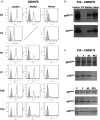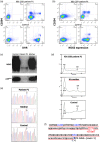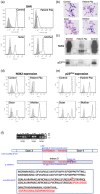Clinical, functional and genetic characterization of 16 patients suffering from chronic granulomatous disease variants - identification of 11 novel mutations in CYBB
- PMID: 32954498
- PMCID: PMC7806450
- DOI: 10.1111/cei.13520
Clinical, functional and genetic characterization of 16 patients suffering from chronic granulomatous disease variants - identification of 11 novel mutations in CYBB
Abstract
Chronic granulomatous disease (CGD) is a rare inherited disorder in which phagocytes lack nicotinamide adenine dinucleotide phosphate (NADPH) oxidase activity. The most common form is the X-linked CGD (X91-CGD), caused by mutations in the CYBB gene. Clinical, functional and genetic characterizations of 16 CGD cases of male patients and their relatives were performed. We classified them as suffering from different variants of CGD (X910 , X91- or X91+ ), according to NADPH oxidase 2 (NOX2) expression and NADPH oxidase activity in neutrophils. Eleven mutations were novel (nine X910 -CGD and two X91- -CGD). One X910 -CGD was due to a new and extremely rare double missense mutation Thr208Arg-Thr503Ile. We investigated the pathological impact of each single mutation using stable transfection of each mutated cDNA in the NOX2 knock-out PLB-985 cell line. Both mutations leading to X91- -CGD were also novel; one deletion, c.-67delT, was localized in the promoter region of CYBB; the second c.253-1879A>G mutation activates a splicing donor site, which unveils a cryptic acceptor site leading to the inclusion of a 124-nucleotide pseudo-exon between exons 3 and 4 and responsible for the partial loss of NOX2 expression. Both X91- -CGD mutations were characterized by a low cytochrome b558 expression and a faint NADPH oxidase activity. The functional impact of new missense mutations is discussed in the context of a new three-dimensional model of the dehydrogenase domain of NOX2. Our study demonstrates that low NADPH oxidase activity found in both X91- -CGD patients correlates with mild clinical forms of CGD, whereas X910 -CGD and X91+ -CGD cases remain the most clinically severe forms.
Keywords: NADPH oxidase; NOX; X-linked CGD variants; clinical severity.
© 2020 British Society for Immunology.
Conflict of interest statement
On behalf of all authors, the corresponding author states that there are no conflicts of interest.
Figures





Similar articles
-
CRISPR-gene-engineered CYBB knock-out PLB-985 cells, a useful model to study functional impact of X-linked chronic granulomatous disease mutations: application to the G412E X91+-CGD mutation.Clin Exp Immunol. 2023 Apr 25;212(2):156-165. doi: 10.1093/cei/uxad028. Clin Exp Immunol. 2023. PMID: 36827093 Free PMC article.
-
Characterization of six novel mutations in the CYBB gene leading to different sub-types of X-linked chronic granulomatous disease.Hum Genet. 2005 Jan;116(1-2):72-82. doi: 10.1007/s00439-004-1208-5. Epub 2004 Nov 6. Hum Genet. 2005. PMID: 15538631
-
Clinical, functional and genetic analysis of twenty-four patients with chronic granulomatous disease - identification of eight novel mutations in CYBB and NCF2 genes.J Clin Immunol. 2012 Oct;32(5):942-58. doi: 10.1007/s10875-012-9698-8. Epub 2012 May 5. J Clin Immunol. 2012. PMID: 22562447
-
Hematologically important mutations: X-linked chronic granulomatous disease (fourth update).Blood Cells Mol Dis. 2021 Sep;90:102587. doi: 10.1016/j.bcmd.2021.102587. Epub 2021 Jun 2. Blood Cells Mol Dis. 2021. PMID: 34175765 Review.
-
[The X+ chronic granulomatous disease as a fabulous model to study the NADPH oxidase complex activation].Med Sci (Paris). 2007 May;23(5):526-32. doi: 10.1051/medsci/2007235526. Med Sci (Paris). 2007. PMID: 17502070 Review. French.
Cited by
-
Chronic Granulomatous Disease (CGD): Commonly Associated Pathogens, Diagnosis and Treatment.Microorganisms. 2023 Sep 5;11(9):2233. doi: 10.3390/microorganisms11092233. Microorganisms. 2023. PMID: 37764077 Free PMC article. Review.
-
Second Report of Chronic Granulomatous Disease in Jordan: Clinical and Genetic Description of 31 Patients From 21 Different Families, Including Families From Lybia and Iraq.Front Immunol. 2021 Mar 5;12:639226. doi: 10.3389/fimmu.2021.639226. eCollection 2021. Front Immunol. 2021. PMID: 33746979 Free PMC article.
-
Late diagnosis and advances in genetics of chronic granulomatous disease.Clin Exp Immunol. 2021 Feb;203(2):244-246. doi: 10.1111/cei.13554. Epub 2020 Dec 13. Clin Exp Immunol. 2021. PMID: 33314034 Free PMC article. No abstract available.
-
Analysis of Pathogenic Pseudoexons Reveals Novel Mechanisms Driving Cryptic Splicing.Front Genet. 2022 Jan 24;12:806946. doi: 10.3389/fgene.2021.806946. eCollection 2021. Front Genet. 2022. PMID: 35140743 Free PMC article.
-
Variant Type X91+ Chronic Granulomatous Disease: Clinical and Molecular Characterization in a Chinese Cohort.J Clin Immunol. 2022 Oct;42(7):1564-1579. doi: 10.1007/s10875-022-01324-3. Epub 2022 Jul 7. J Clin Immunol. 2022. PMID: 35796921 Free PMC article.
References
-
- Mahlaoui N, Picard C, Bach P et al Genetic diagnosis of primary immunodeficiencies: a survey of the French national registry. J Allergy Clin Immunol 2019; 143:1646–1649.e1610. - PubMed
Publication types
MeSH terms
Substances
LinkOut - more resources
Full Text Sources
Other Literature Sources
Miscellaneous

